After locking up on 13th November to make way for the 2022 FIFA World Cup, Ligue 1 is back. Top-flight football returned to France on 28th December and one of the most engrossing games was Lyon vs Brest. This fixture saw Laurent Blanc secure his third win in six games since taking charge of Les Gones after Peter Bosz’s tenure went down in flames following a five-game winless run.
In Blanc’s six league games since assuming the Groupama Stadium hot seat, his side has generated an xG of 11.19, besting the preceding six-game run under Bosz which saw Lyon generate 9.12 xG. Meanwhile, Blanc’s six games have seen Lyon concede 8.18 xG, which is very similar but a slight increase on the 8.58 xG they conceded in the six games before the former PSG and France boss’ arrival.
Six games is an extremely small sample and all of this should be taken with a big grain of salt but these stats, along with results, provide positive early signs for the 1998 World Cup winner’s return to club management in his home country. Performances have improved, as has the atmosphere surrounding the club.
On the other side of things here, Wednesday also marked Bruno Grougi’s sixth game in charge of Brest on a caretaker basis since Michel Der Zakarian departed from the Brittany-based club 10 games into the 2022/23 campaign with Les Pirates sitting rock bottom at the time of his exit.
Since Grougi took to the helm as caretaker boss, Brest have generated 10.19 xG, a substantial increase on the 5.48 xG they created in the final six games of Der Zakarian’s reign. Les Pirates have conceded 10.11 xG in that time, similar but again a slight improvement on the 10.42 xG they conceded in the dying days of Der Zakarian’s tenure.
So, both of these sides have created more goalscoring opportunities in the last six games following their respective managerial switch-ups and that probably won’t come as a surprise, given that this contest finished with six goals, shared unevenly in favour of Lyon, who came away with a 4-2 victory.
Our tactical analysis piece looks at the strategies and tactics used by both of these sides in Wednesday evening’s game. In particular, our analysis will look at how Lyon managed to open up Brest on so many occasions, generating a solid xG of 2.75 to Brest’s 1.6.
We will focus on how Lyon emphasised the point that Brest’s defence is in dire need of improvement via their build-up, ball progression and outstanding attacking off-the-ball movement; these factors contributed greatly to Blanc’s side decimating Brest’s defensive shape time and time again, creating plenty of good goalscoring opportunities for the away side.
Similarly, we’ll look at how Lyon’s defensive shape was nothing to write home about either, and how Brest failed to take opportunities to unlock up their opponents’ defence more frequently too.
Lineups
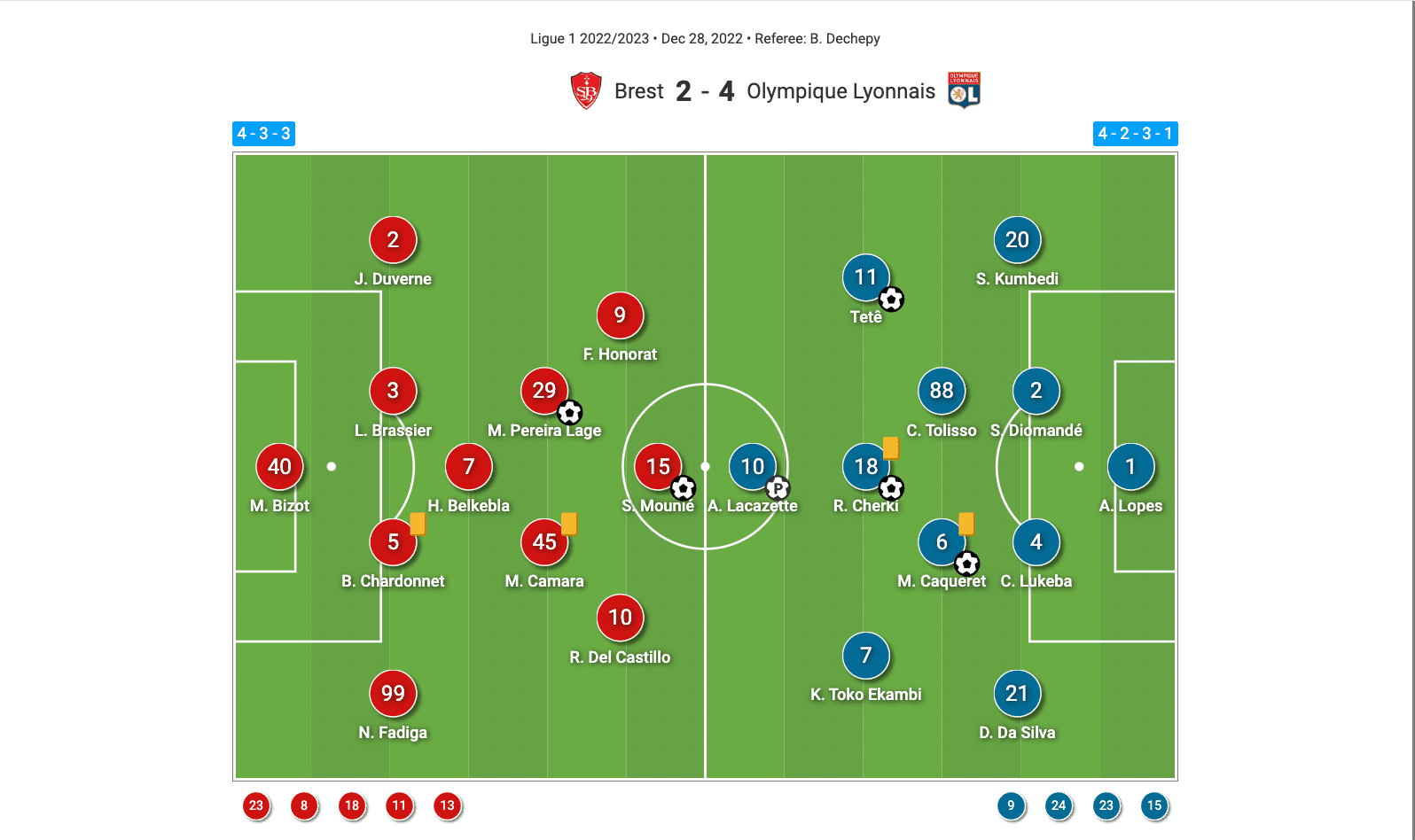
Let’s take a quick look at the lineups. Starting with the home side, Grougi lined his team up in a 4-3-3 shape for this contest. Marco Bizot played in goal for the hosts behind a back-four consisting of right-back Noah Fadiga, right-centre-back Brendan Chardonnet, left-centre-back Lilian Brassier and left-back Jean-Kévin Duverne.
Haris Belkebla started at the base of Brest’s midfield, with Mathias Pereira Lage and Mahdi Camara playing on either side of him, just ahead in central midfield. Franck Honorat and Romain Del Castillo played on the wings with Steve Mounie playing up front to complete Brest’s starting XI.
Grougi made five substitutions before the final whistle blew, the first two of which came in the 67th minute. Islam Slimani came on for Pereira Lage and Hugo Magnetti replaced Camara. Slimani’s entrance to the field saw Brest change from a 4-3-3 to a 4-4-2. Brest made another double substitution in the 75th minute, with Christophe Hérelle coming on for Fadiga and Karamoko Dembele taking over from Honorat. Les Pirates’ final change occurred in the 84th minute; Axel Camblan took to the field as Del Castillo made way.
As for the visitors, Blanc set his team up in a 4-2-3-1, with Anthony Lopes starting in goal behind a back-four made up of 17-year-old right-back Saël Kumbedi — making his first senior start for Les Gones — right centre-back Sinaly Diomandé, left centre-back Castello Lukeba and makeshift left-back Damien Da Silva.
Corentin Tolisso and Maxence Caqueret started at the base of Lyon’s midfield behind right-winger Tetê, left-winger Karl Toko Ekambi and ‘10’ Rayan Cherki. Lastly, Alexandre Lacazette led the line for Blanc’s side.
The former centre-back who lined out for Montpellier, Napoli, Nîmes Olympique, Saint-Étienne, Auxerre, Barcelona, Marseille, Inter Milan and Manchester United during his illustrious playing career made four substitutions versus Brest on Wednesday.
Blanc’s first substitution came in the 58th minute and saw Johann Lepenant replace Tolisso in midfield. Next, Romain Faivre came on for Cherki in the 70th minute. Then, in the 81st minute, Blanc made a double substitution which saw Moussa Dembélé replace Tetê and Thiago Mendes replace Caqueret.
Lyon’s build-up and ball progression
Now, let’s move on to what we’re (hopefully) here for: the tactical analysis! We’ll start off by looking at Lyon’s build-up and ball progression, analysing how Blanc’s side cut through Brest’s defensive shape in the first two phases of possession play to generate plenty of final third entries. By the end of the game, Les Gones had made 52 passes into the final third, dwarfing Brest’s 29 passes into the final third and underlining just how strong Lyon were at cutting through Brest in the first two possession phases.
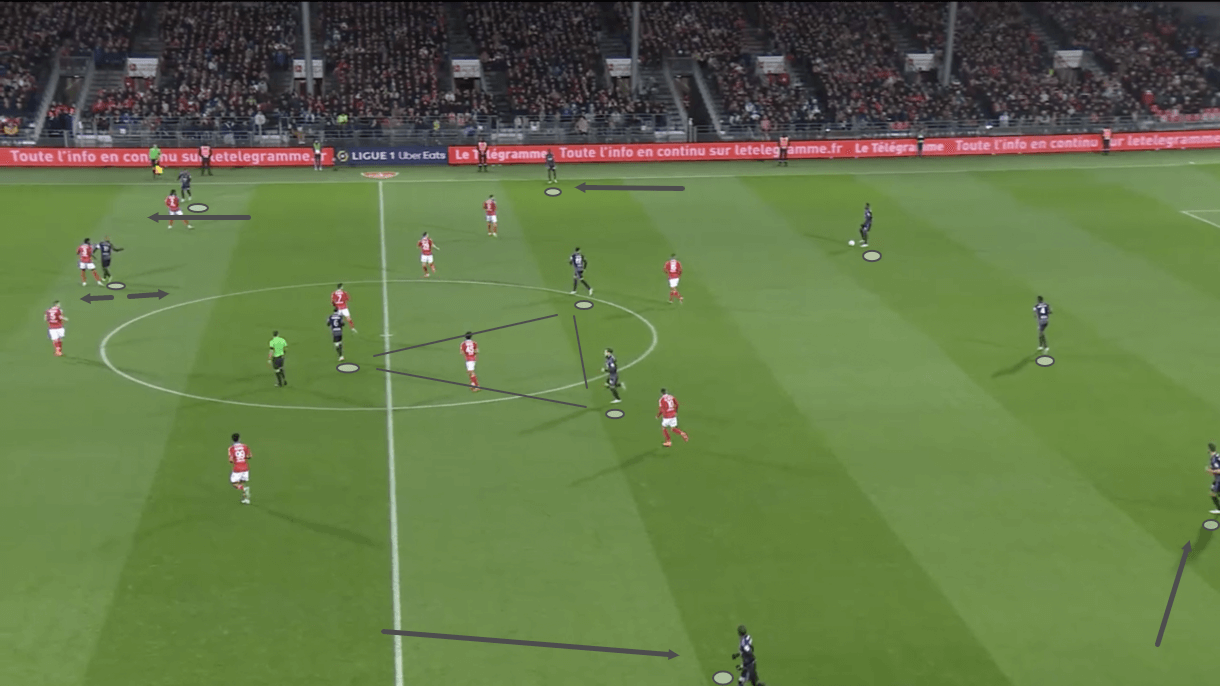
Figure 2 shows us a typical example of Lyon’s shape during the build-up/ball progression phases from Wednesday’s game. Da Silva, a natural centre-back, would tuck in to form a back three in possession quite quickly — not directly from the goal-kick but certainly before his side reached the halfway line — while Kumbedi pushed high and wide on the wing. Toko Ekambi dropped to play Kumbedi’s role on the opposite side, then, ensuring balanced width on either wing.
Tolisso, Caqueret and Cherki formed some kind of triangle in midfield, though the exact positioning wasn’t so strict. The important thing here was that at least one player always occupied a more advanced position, making sure not all three were positioned on the same horizontal line. For the most part during this game, all three occupied different horizontal lines with none playing alongside each other, though we can see a deep Cherki playing next to Tolisso in this particular image momentarily.
Up front, Tetê typically offered depth, providing out-to-in runs in behind from the right wing throughout the game. His intelligent run timing and pace were a constant threat to the space behind Brest’s backline. Meanwhile, Lacazette could also provide an option in behind with his runs and pace but was also sometimes found dropping off in between the lines. He could effectively go either way depending on the situation and how he reacted to the changing picture around him; he was difficult for Brest to control and mark throughout the contest.
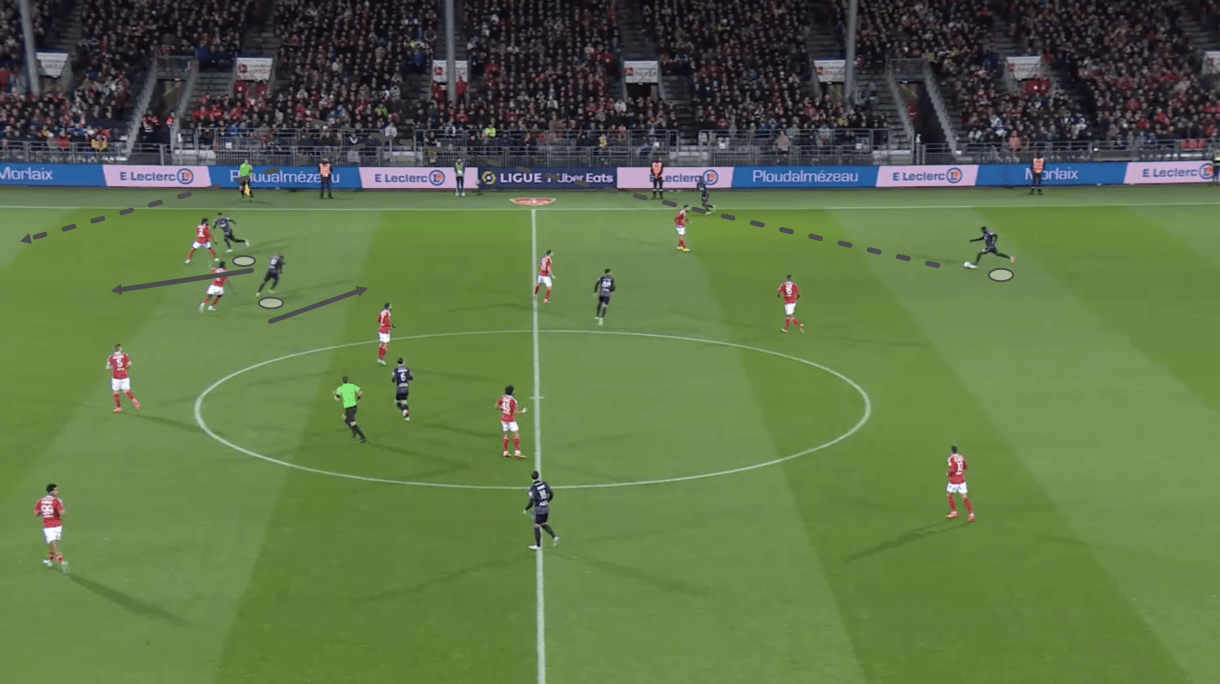
Now that we’ve got an idea of the individual roles within this offensive setup, how did they come together to create chances for Lyon? Let’s take a look at some examples, starting with figure 3. Here, we see Diomandé floating a ball over the top for Tetê to chase as he seeks to exploit space behind Brest’s backline with Les Pirates sat in their 4-3-3 mid-block, where they were often found during the game.
The midfield five, if you like, formed by Lyon in possession as discussed above and the more advanced duo of Lacazette and Tetê provided the deepest Lyon players — the back three — with different options. Their job in the progression phase was to find ways of giving the deep ball carriers different options on the ball, whether that was an option behind the midfield line as Caqueret, Cherki and Lazazette often provided; a short option in space out wide, as Kumbedi and Toko Ekambi often provided; an option just behind the first line of pressure as Tolisso often provided; or an option all the way in behind the opposition’s backline, as Lacazette (again) and Tetê often provided.
In figure 3, Lacazette has just dropped off, dragging Brest’s left centre-back with him, creating space for Tetê to exploit as he makes his out-to-in run behind the full-back and towards the space behind Brest’s back four.
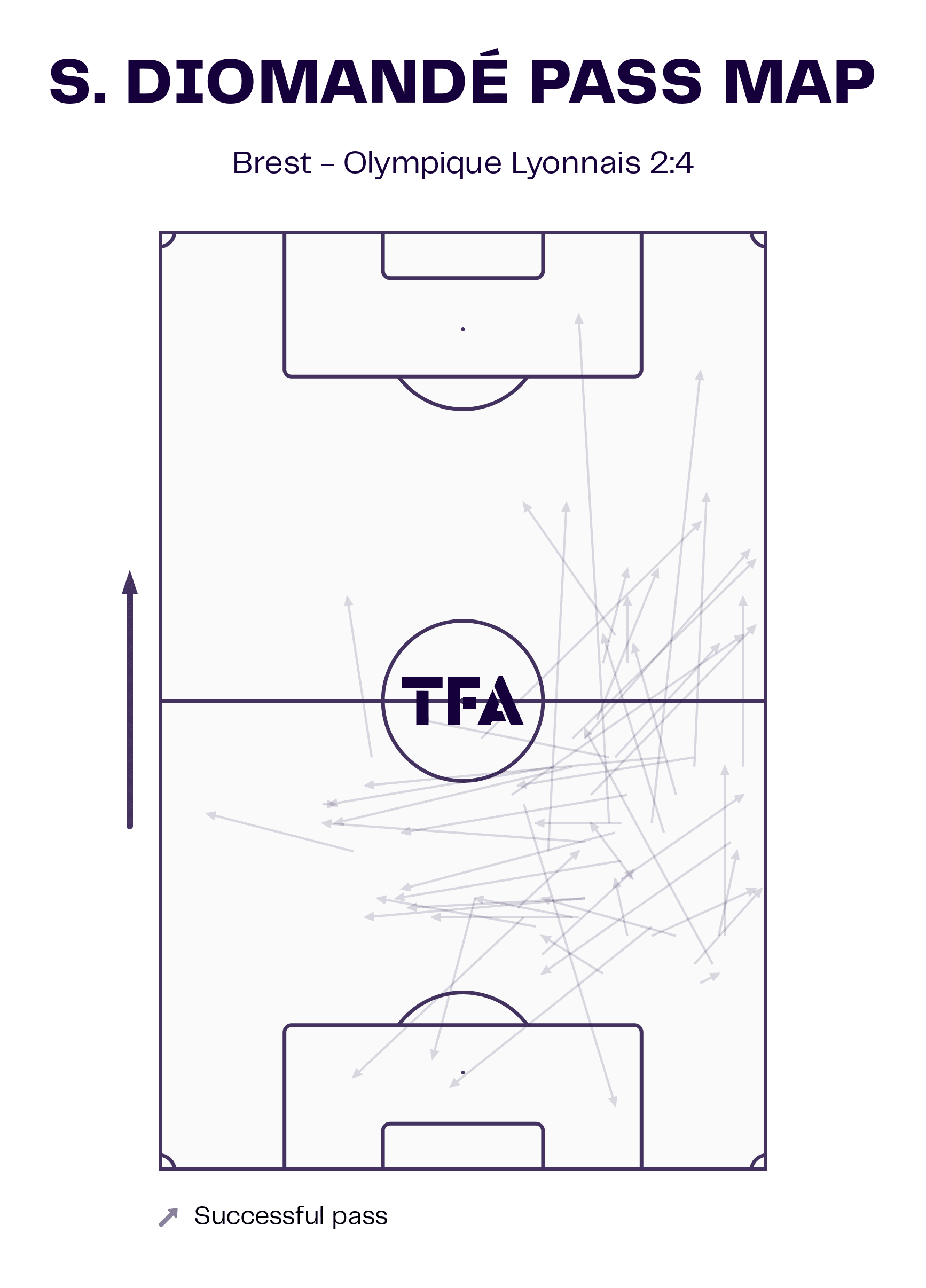
Diomandé, in particular, was persistent in this regard throughout Wednesday’s game. He ended the contest with four progressive passes made to Lacazette and three made to Tetê. His pass map in figure 4 shows us how common it was to see him driving the ball into the half-space, out to the wing or, indeed, as we see in figure 3, in behind the opposition’s backline for the striker or right-winger to chase down.
However, we saw Lukeba doing this too and it was actually his crossfield ball over the top and in behind for Lacazette that was the catalyst for Lyon’s first goal of the game.
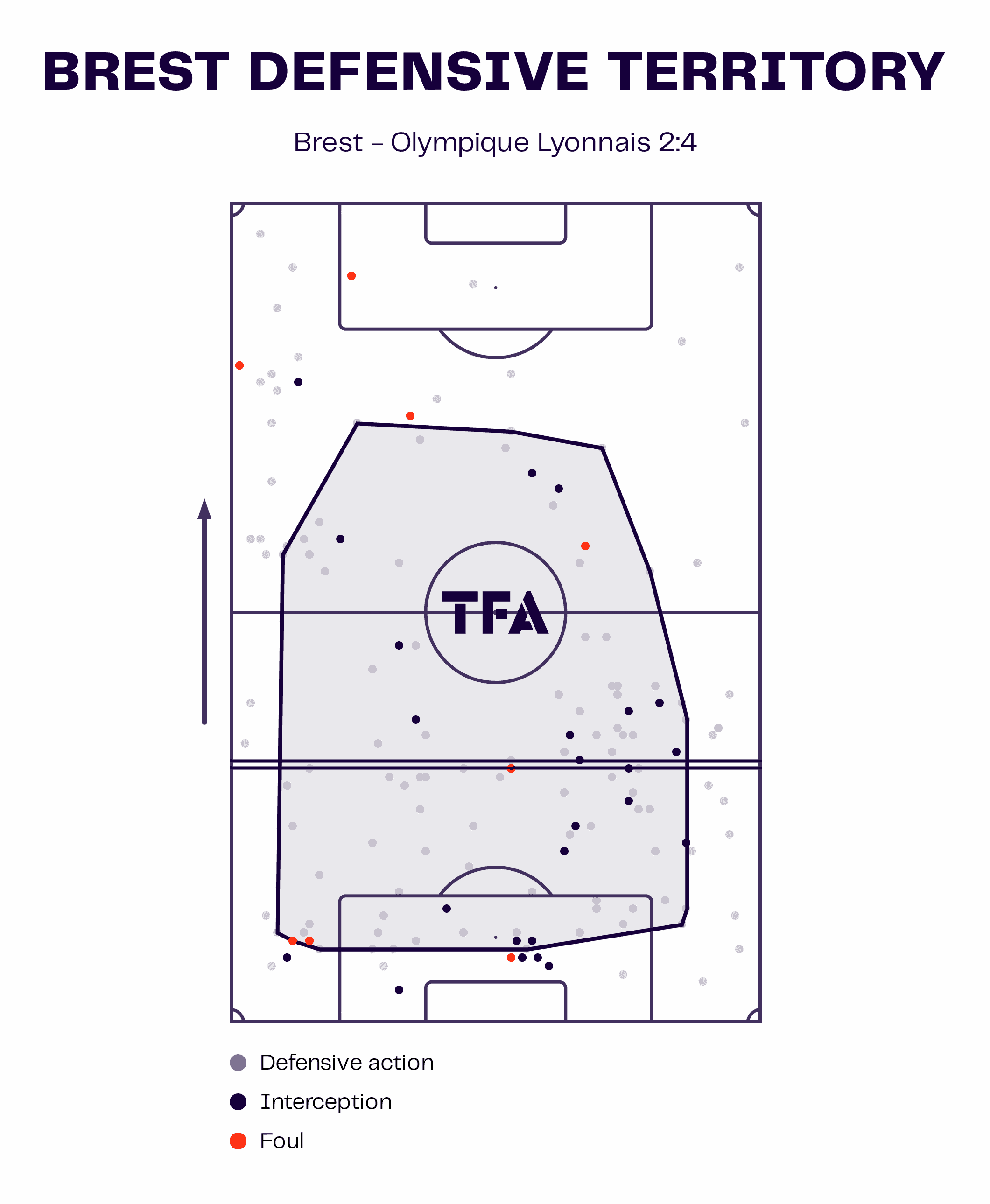
Brest didn’t press high in this game. They typically defended in a mid-block, allowing Lyon to progress into their half before engaging. They allowed enough space for Lyon to exploit behind their backline as they didn’t just sit on the edge of their box, but, fatally, they applied no pressure to Lyon’s backline and allowed the likes of Lukeba and Diomandé way too much time on the ball which the centre-backs used to hurt them.
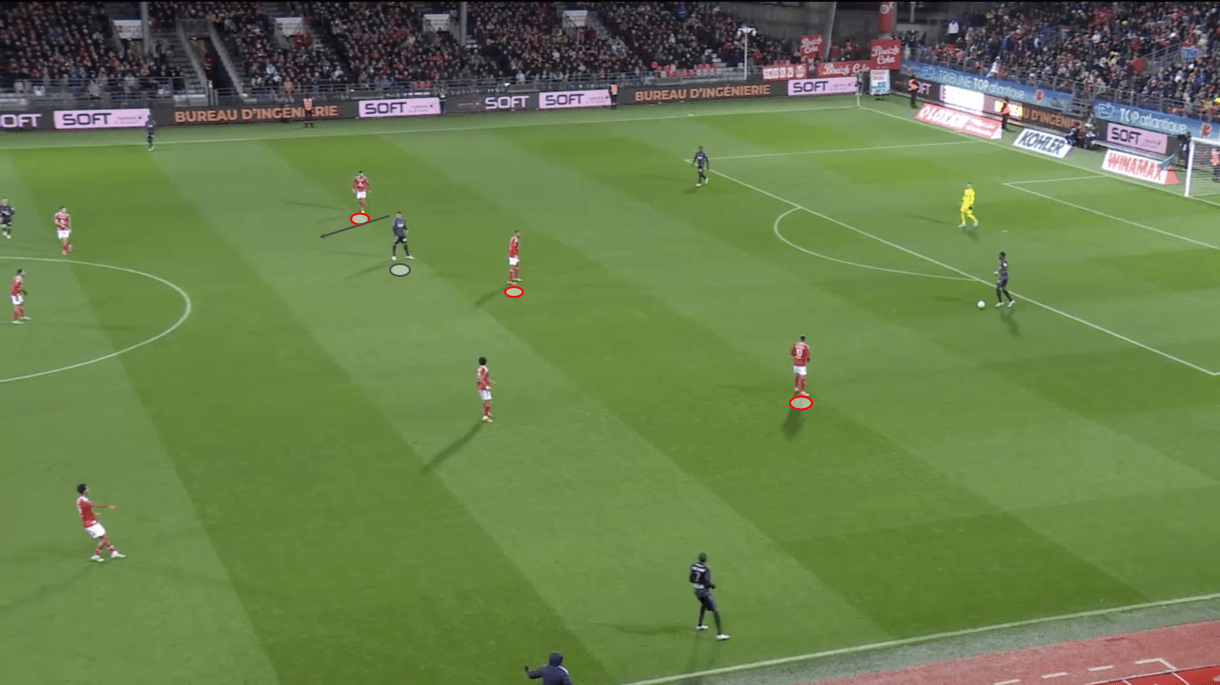
Brest’s front three was, in theory, supposed to block off passes from Lyon’s backline into the midfield line. Mounie would place the deepest midfielder — usually Tolisso — in his cover shadow while the wingers would place the wide options in their respective cover shadows. We see an example of this in figure 6. Any midfielders that dropped deep to help Tolisso out would be the responsibility of the central midfielders to cover off.
However, Lyon found their way past this first line of defence very easily a lot of the time through the on-the-ball quality of the players in their backline and the quality of movement behind these players. Lyon’s movement will get its own section in our analysis, so you’ll have to be patient before we get into the intricacies of that, but as a teaser, when we move on to figure 7 below, we can see how Tolisso, after checking his shoulder and seeing how much space he had behind him in figure 6, escaped Mounie’s cover shadow and gave Lukeba a good option beyond Brest’s forward line.
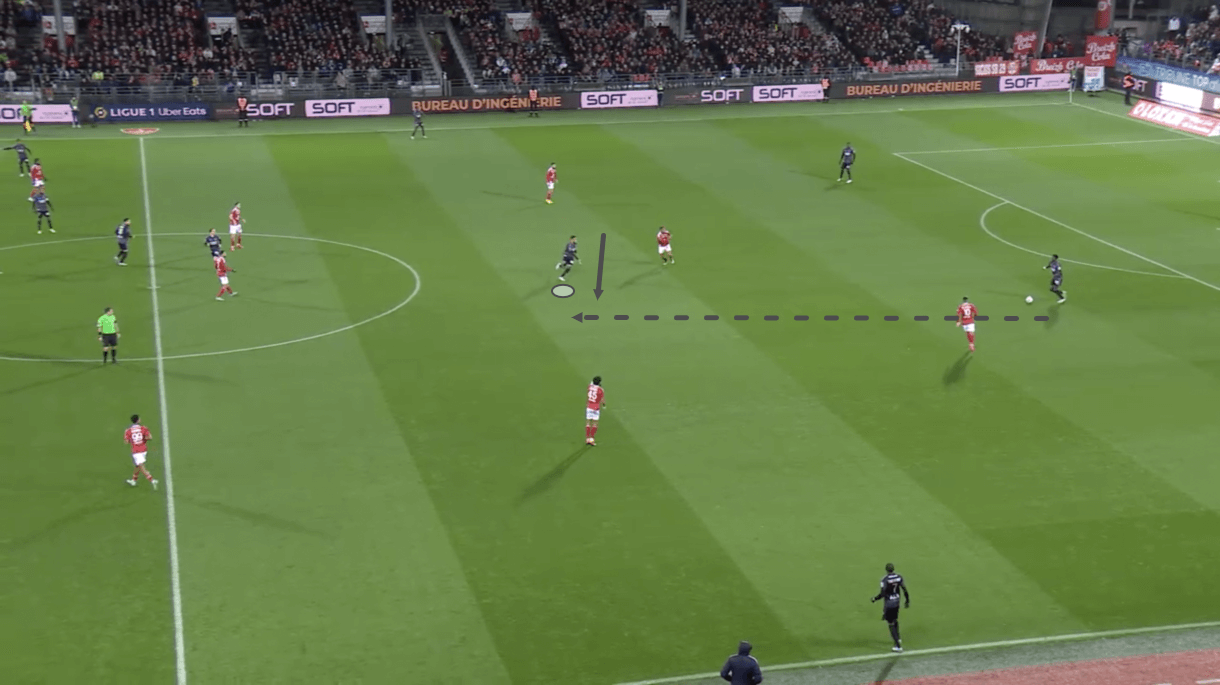
Tolisso receives the ball here and is basically already facing forward, giving himself a great chance to drive his team into the opposition’s half.
The former Bayern Munich midfielder escaped Mounie’s cover shadow with his intelligent movement on several occasions throughout Wednesday’s game and did a great job of providing options for his backline behind that first line of Brest’s defence.
When Lyon were in their own third, as we saw in figures 6-7, Brest’s defensive shape generally wasn’t compact enough considering how they applied no pressure to Lyon’s backline. There was way too much space for Tolisso to blatantly scope out and subsequently exploit behind Les Pirates’ high but passive forward line.
Perhaps this level of compactness wouldn’t have been as harmful if Brest had planned to apply pressure to Lyon’s centre-backs, but considering how much time the deep Lyon players had to pick out their passes and make their way out of their third, Brest left way too much space between the lines for them time and time again. Players at the quality of those in Lyon’s backline don’t need that much time and space to split you open, as they showed on Wednesday.
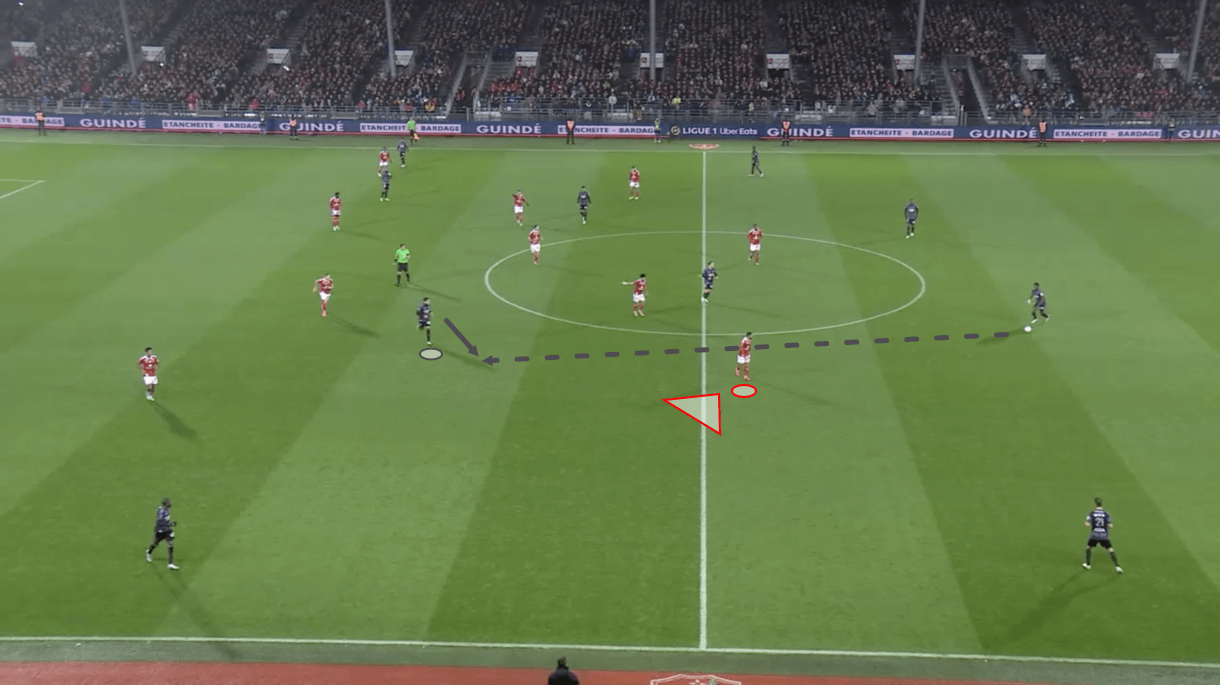
Figure 8 shows another example of movement helping Lyon to break Brest’s first, and in this case, even second, line of pressure. Again, the winger is focusing on keeping the wide option in his cover shadow but Cherki is able to create a passing lane between Brest’s winger and right central midfielder, giving Lukeba a great line-breaking option behind the midfield line, dragging a centre-back out to deal with him and distorting Brest’s defensive shape in the process.
Again, there’s too much space for Cherki here and no one is really dealing with him. He’s escaped the holding midfielder’s zone but the central midfielder on that side is occupied by Tolisso, who Mounie’s not really dealing with at all by this stage. This is what forces the centre-back to come out but it’s not an ideal way of managing the situation for Brest.
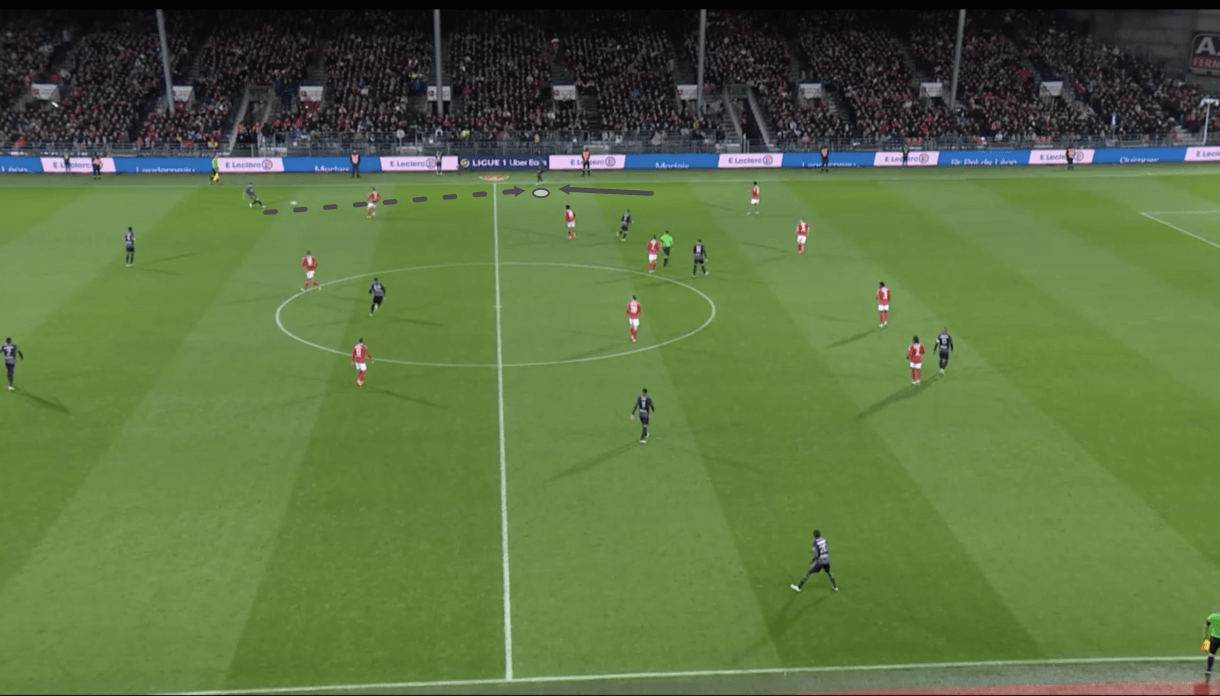
As for the wide options, Lyon particularly used Toko Ekambi frequently during the game as a short option outside of Brest’s 4-3-3 defensive shape. He often enjoyed plenty of space out wide as Lyon looked to progress from their half to the opposition’s half.
Sights like the one we see in figure 9 were not uncommon, and Toko Ekambi enjoyed plenty of opportunities to receive in space, turn and either run at Brest’s full-back or link up with a teammate — Cherki, Caqueret and Lacazette often provided good link-up options for Toko Ekambi as he looked to progress his side into the final third from the left wing.
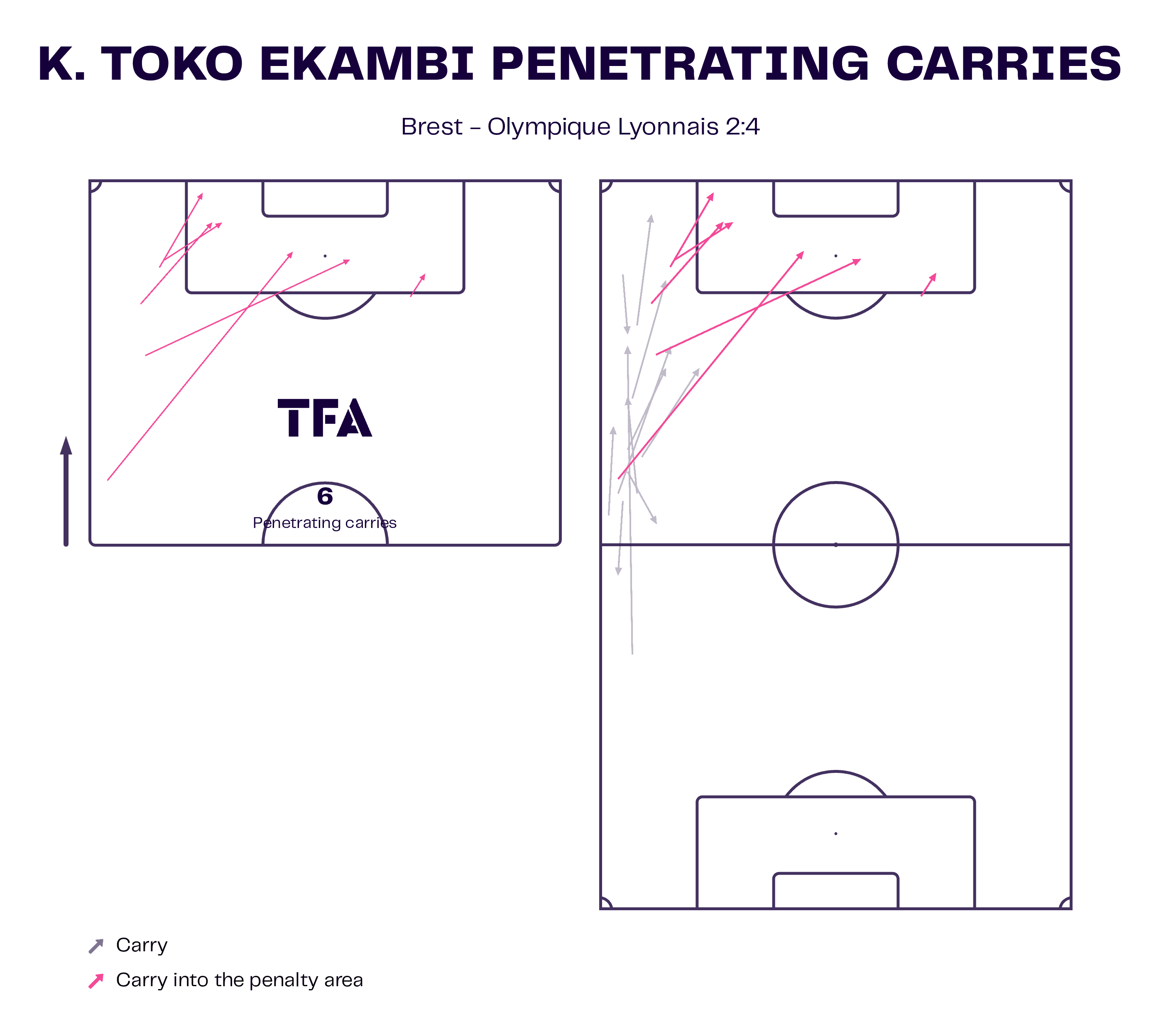
Figure 10 highlights the Cameroonian’s penetrating carries versus Brest, and this figure shows how he often drove his side into the final third from deep on the left wing during Wednesday’s game, as well as being a great help inside the final third at times when tasked with breaking into the penalty area.
Lyon’s off-the-ball movement
Moving on to our next section, now we’ll focus more heavily on Lyon’s off-the-ball movement and how it played such a key role in their progression into the final third versus Brest on Wednesday.
Brest’s defence was constantly one step behind Lyon’s attack as they entered the final third because of how Lyon’s players were so in tune with one another and reacted instantly to each other’s movement. Their level of awareness concerning their teammates’ movement and the opposition’s movement was fantastic from Lyon in this game. This allowed them to instantly leverage space as it was created and punish the opposition with that space.
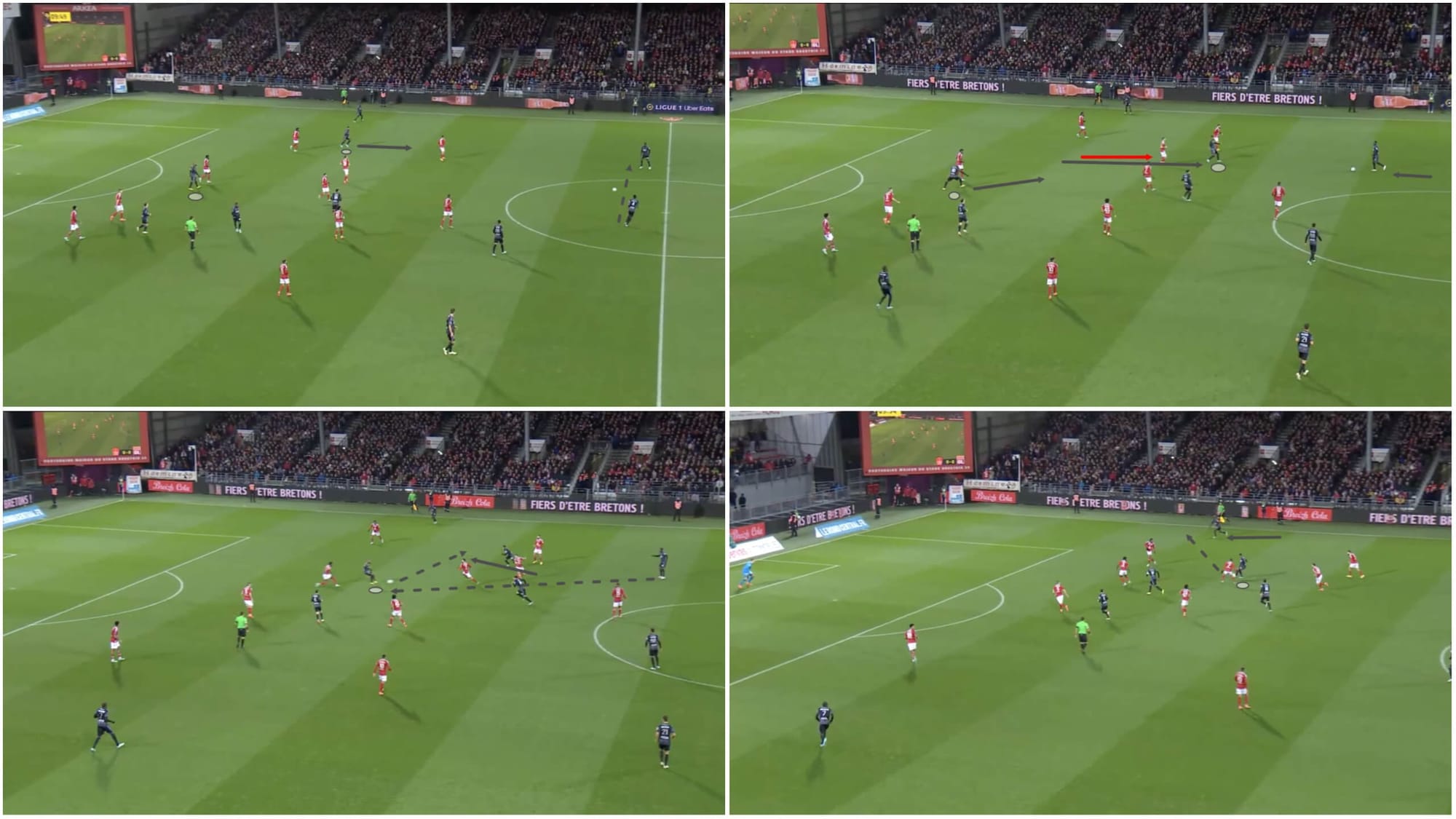
We mentioned earlier that Lacazette could drop in between the lines or provide an option in behind. We already discussed how his movement in behind helped Lyon to score their opening goal of the game and in figure 11, we see how his movement into deeper positions helped Lyon to enter the final third and create a decent chance.
Firstly, we see Tetê drop deep from the right half-space as Diomandé gets on the ball and drives forward into the space ahead of him in the opposition’s half with Lyon in the chance-creation phase.
Tetê’s movement drags opposition players with him and opens space between Brest’s midfield line and defensive line for Lacazette to drop into and exploit, which is what happens as he gets onto the end of Diomandé’s line-splitting pass in the bottom-left quadrant above. From there, Lacazette can put the ball into Tetê’s path, with the winger now facing forward and able to send it out to overlapping right-back Kumbedi who’s got space to work with on the right wing inside the final third.
This is a great example of unselfish movement and the excellent teamwork that was prevalent in Les Gones’ game on Wednesday. Tetê dropped and opened space for Lacazette to work with. Then, Lacazette could return the favour and slide the ball into Tetê’s path with the winger in a much more favourable position to receive the ball now.
Lacazette reacted quickly to Tetê’s movement and the space opening up. The former Arsenal striker took advantage of the window of time after Tetê’s movement when so much space was available between the lines, gave Diomandé an excellent option and managed to link up with his teammates to create a well-worked final third entry for Lyon.
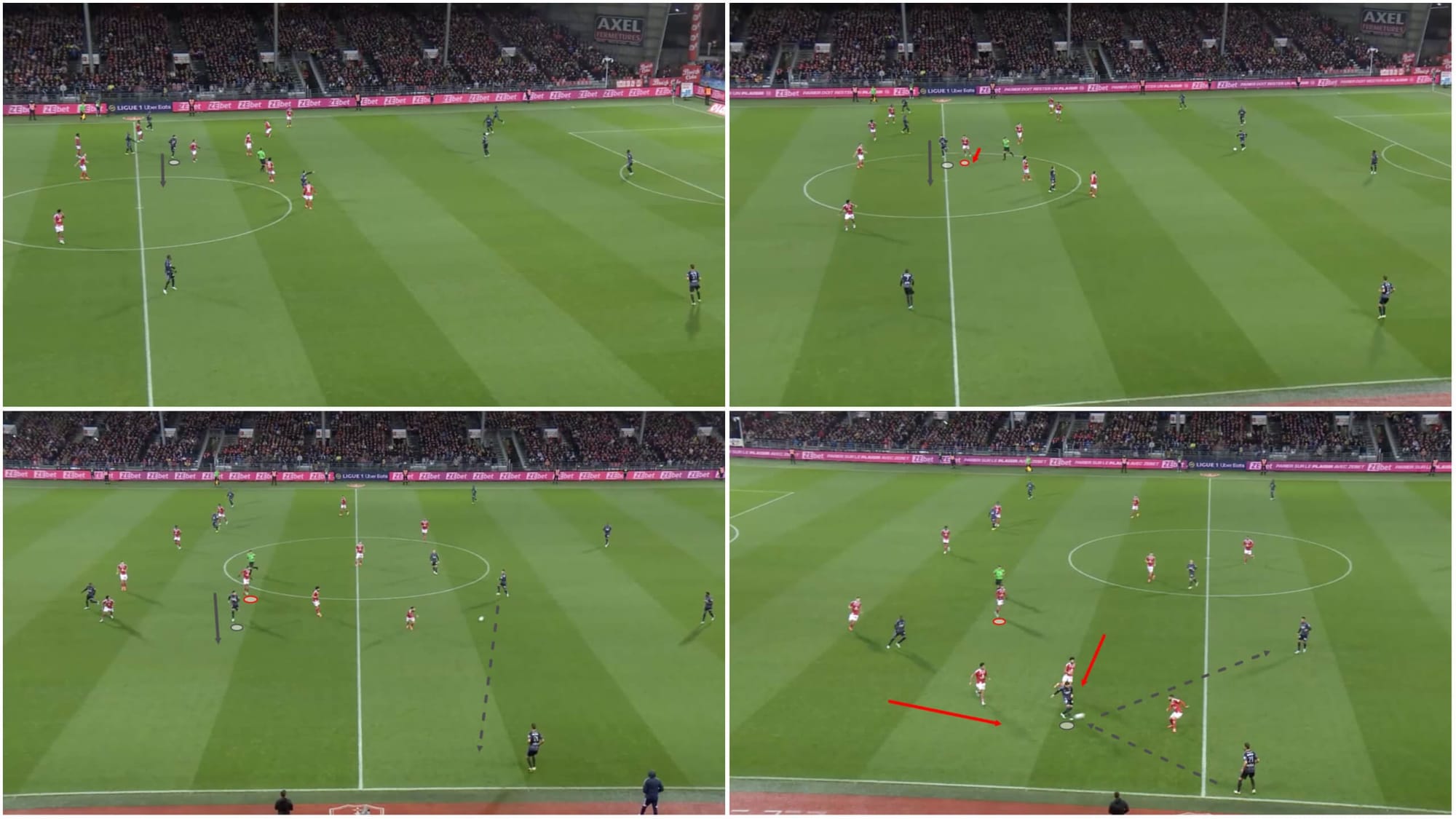
Cherki and his off-the-ball movement were a constant nuisance for Brest, especially holding midfielder Belkebla, throughout this fixture. Take figure 12, for instance. Here, the 19-year-old playmaker drifts across from the right half-space to the left wing, getting picked up by Belkebla as he enters his zone centrally but losing the Brest midfielder as he leaves this zone and continues drifting out to the left wing.
As he moves out wide in the bottom left and bottom right quadrants, we see how he loses his marker, who doesn’t want to get dragged out of position and allow so much space to open up between the lines, forcing different Brest players to step out and mark the ‘10’. However, it wasn’t clear for Brest who should pick him up; the wide areas where we saw Toko Ekambi picking up the ball back in figure 9 were a little bit open for Brest and Cherki exploited that space here.
The right-back steps up and the right central midfielder steps out in the end but neither is quick enough to prevent Cherki from receiving this pass, relaying the ball into midfield and giving Tolisso the chance to get his head up facing a weakened Brest defence that’s been pulled around a bit thanks to Cherki’s movement, making progress from here through to the final third an easier prospect than it normally would be.
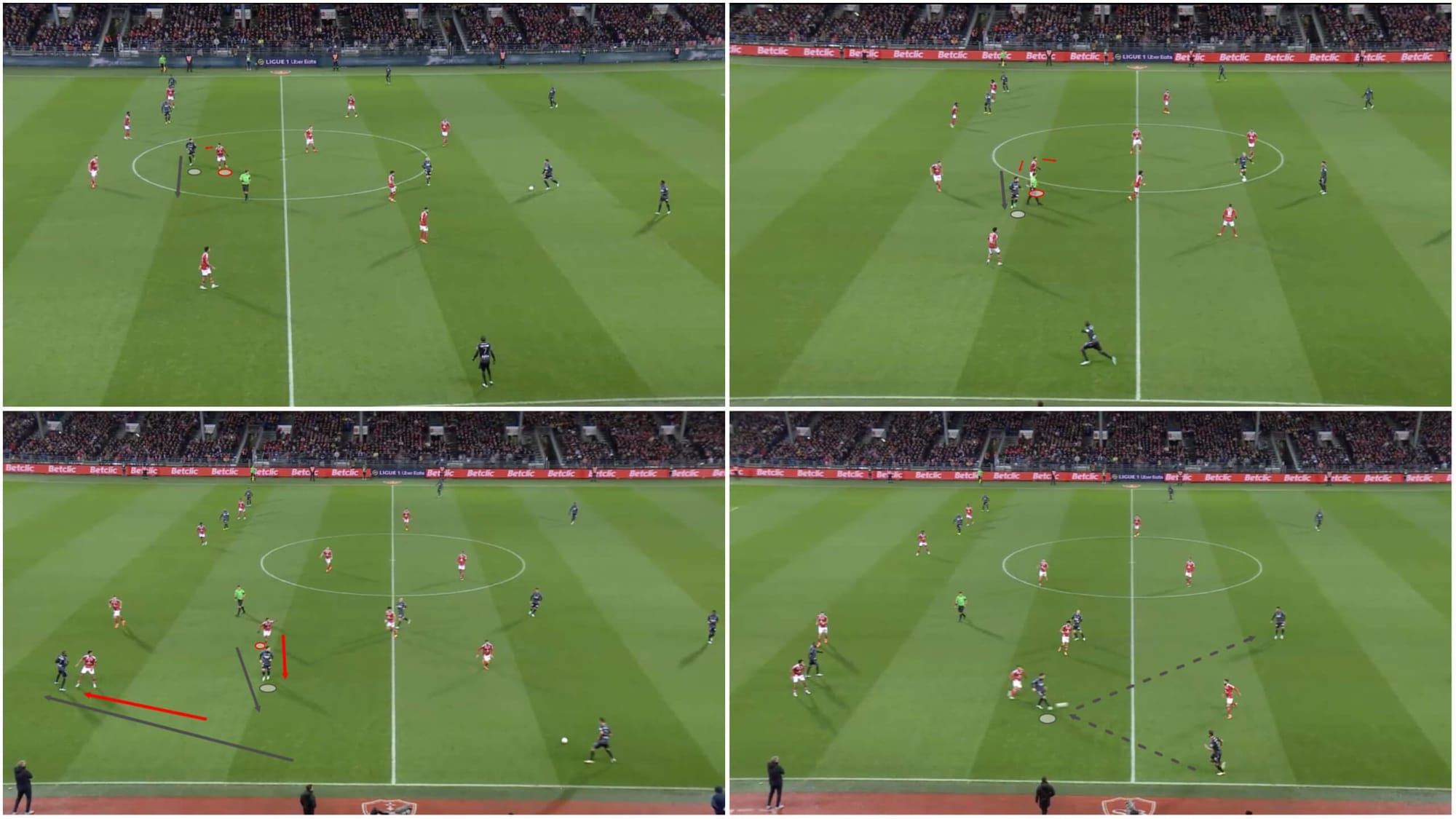
In figure 13, from slightly later in the first half, we see another example of Cherki drifting across to the left. This time, however, an unselfish run from Toko Ekambi up the left wing targeting space behind Brest’s backline occupies the right back and prevents him from stepping up to take Cherki from Belkebla. As a result, a likely stressed and caught-in-two-minds Belkebla is forced to follow Cherki out to the wing.
However, there was hesitance from the holding midfielder before he committed to stepping out as he looked around for other options to cover the ‘10’. This gave Cherki the time he needed to receive this pass and lay it off to Tolisso just as he did in the previous example, yet again allowing the 28-year-old midfielder to get on the ball facing a weakened Brest with a displaced holding midfielder opening up plenty of space for the Frenchman to target between the lines.
As play moves on, we actually see Toko Ekambi drift centrally, looking to exploit the space Cherki opened up, again showing how Lyon’s attackers did so well to react to the changing picture around them and take advantage of space their teammates had created for them via their movement that pulled Brest’s defenders all over the place into a disorganised, open state.
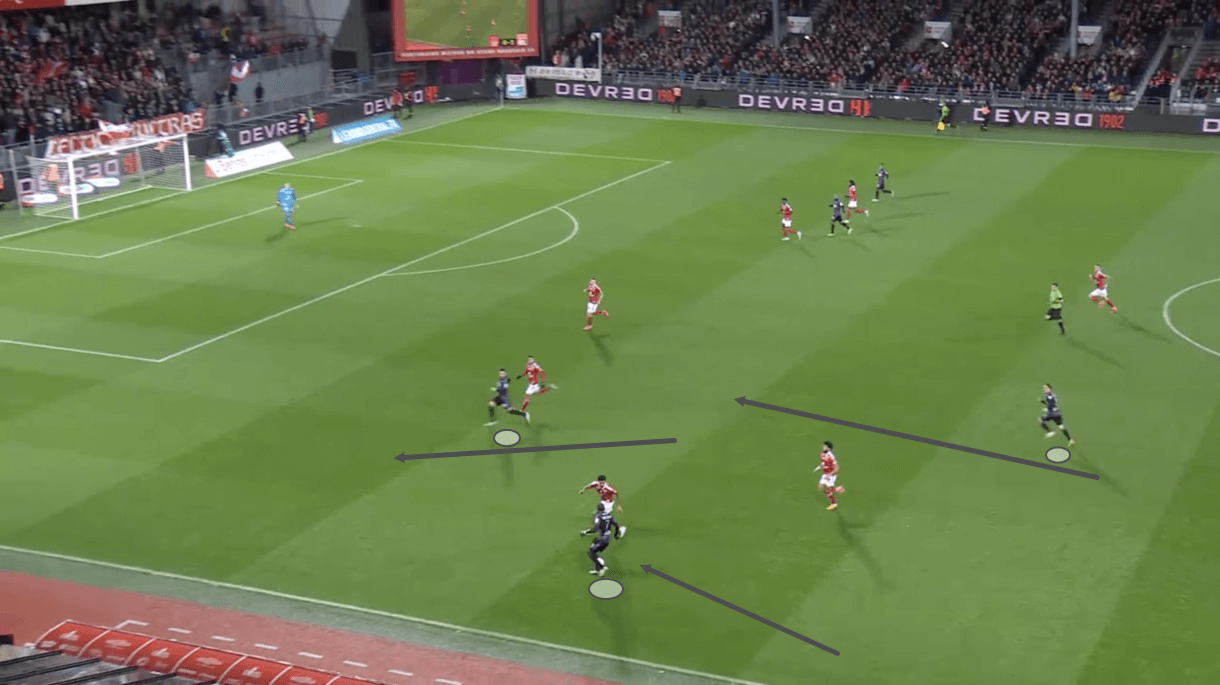
On the left wing, it was common to see Toko Ekambi, Cherki/Lacazette and Caqueret linking up as a wide triangle. Again, they’d take advantage of each other’s movement to exploit space as it opened up. Advancing from deep positions and seeing the picture change in front of him as Cherki or Lacazette pulled out wide, Caqueret enjoyed the freedom to probe forward and exploit this space with late final third entries that Toko Ekambi or the drifting attacker — in figure 14, Cherki — could pick up on to link up with the midfielder.
In this example, the ball was played wide and Toko Ekambi began carrying it forward, attracting the full-back and wide midfielder out to him. Meanwhile, Cherki started targeting the space that’s now opened up behind the full-back, dragging the holding midfielder with him as a result. This created space for Caqueret to target on the left side of midfield, as seen in figure 14. The ball does fall to Caqueret following Toko Ekambi’s dribble, but a poor first touch denies the midfielder a successful final third entry. However, we saw plenty of moves like this from Les Gones in Wednesday’s game.
Again, this is a great example of Lyon’s attackers creating space for one another and reacting to each other’s movement to get into the final third.
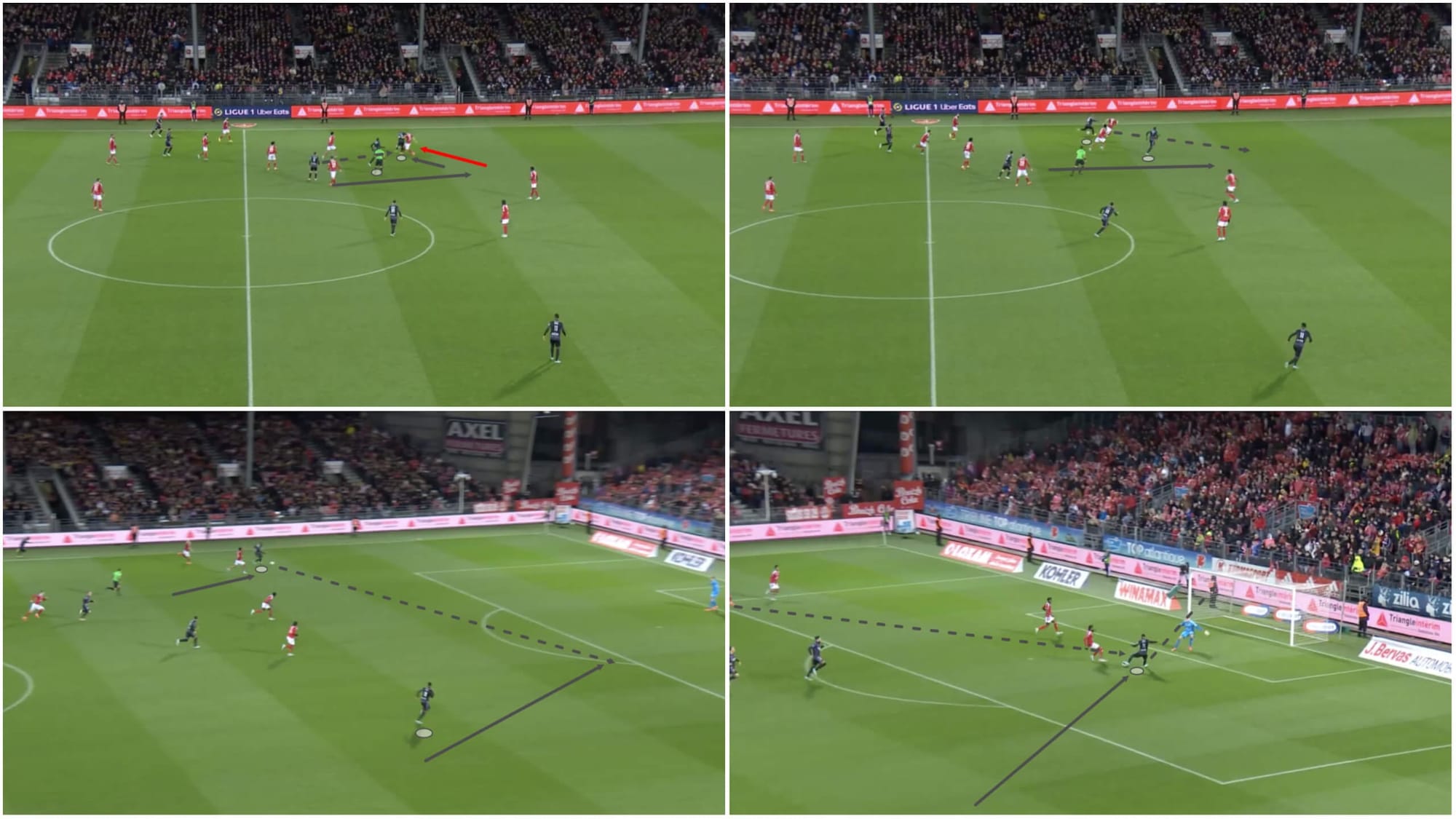
These attacking principles helped Lyon to get their fourth and final goal of the game in the early stages of the second half. Toko Ekambi ran into space created by Lacazette as the striker pulled out to the left wing to get on the ball, dragging the centre-back with him in the process.
The ball found its way through to Toko Ekambi who had loads of space to exploit behind the opposition’s backline. He was able to slide the ball across the goal and into a great goalscoring position for Tetê to finish the move off wonderfully.
Lyon’s defensive approach
Lyon dominated the ball for the most part in this match, ending the contest with 57.55% possession. They did press more aggressively than Brest, though that’s not saying a lot, ending the game with 7.11 PPDA to Brest’s 16.14 PPDA — indicating a press that was about twice as aggressive as their opponents. However, Brest missed opportunities to play through Lyon’s defence, and Les Gones’ defensive structure was not perfect.
Indeed, Lyon didn’t concede from open play in this game. However, they still allowed Brest 14 shots, just one less than they managed themselves, and 1.6 xG, which doesn’t scream ‘great defensive performance’.
Yes, Lyon performed very well on the ball in Wednesday’s game, but they leave plenty of room for improvement in their defensive game.
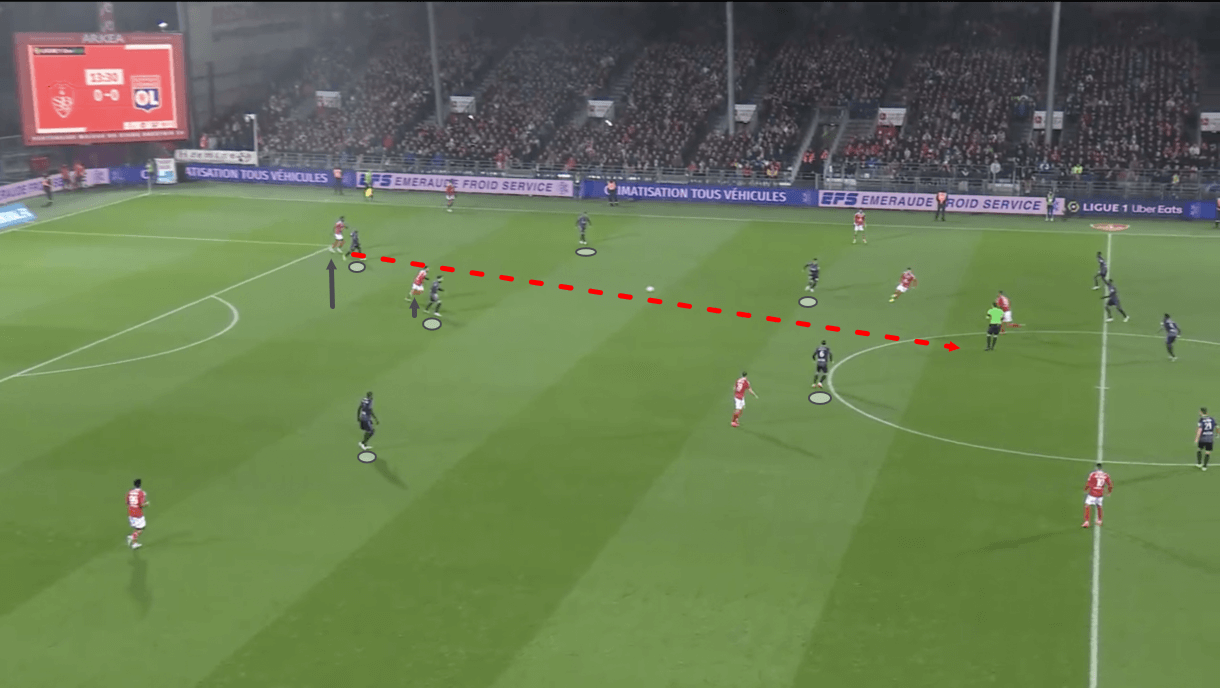
Lyon generally defended in a 4-2-3-1, as figure 16 above indicates. Lacazette would press the ball-carrying centre-back while trying to cut the pitch in half, keeping the opposite centre-back covered with his pressing, while Cherki would man-mark the opposition’s holding midfielder.
The ball-near Lyon winger would retain access to the opposition’s ball-near full-back while trying to keep the winger in his cover shadow, while the ball-far winger had the license to come across centrally, ensuring Lyon kept the central zones compact and difficult to play through.
Lyon’s deep midfielders marked zonally and were oriented quite positionally; they weren’t easily drawn out of position as, perhaps, Brest’s midfielders and defenders were so often. However, it was, then, possible for Brest’s attackers to exploit space between the attacking line and midfield line or, as we see in figures 16-17, between the midfield line and defensive line.
Ideally, one of Lyon’s holding midfielders would react quickly and intercept this pass as it goes to Mounie from the left centre-back but Tolisso doesn’t make it to the ball in time, allowing Mounie to receive the ball behind the midfield line and knock the ball into his teammate’s path as he advances from off Tolisso’s shoulder.
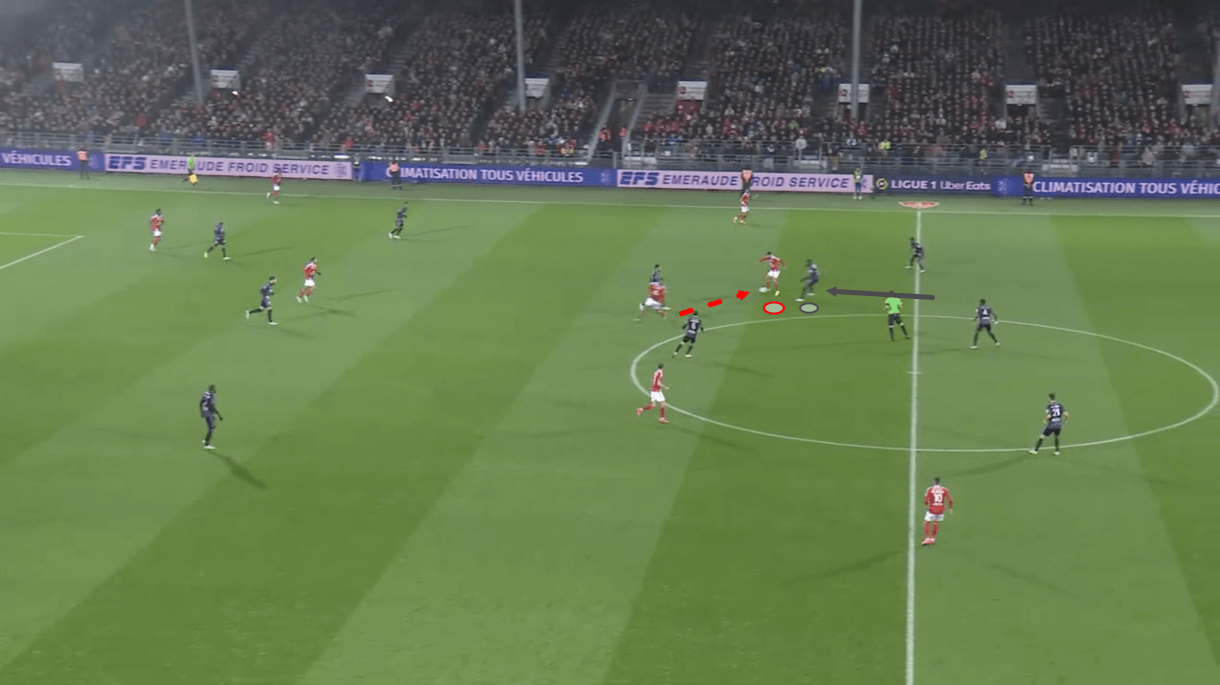
The ball is received, but Diomandé does well to step out and stop this attack. Lyon’s centre-backs had to act aggressively and step out in situations like this to ensure the space between the lines wasn’t exploited. They did a better job than Brest’s centre-backs of getting tight to the attackers and denying them the opportunity to exploit this space.
However, much of Brest’s play was slow and, at times, lackadaisical. They could’ve made it more difficult for Lyon’s defence which wasn’t perfect. However, their play wasn’t quick and crisp enough to really impact Lyon and punish them for leaving space open for them — in contrast to Lyon’s possession play.
This was the big difference between the two teams; one was alert and ready to exploit space as it opened up almost immediately all the time, while the other was slow, laboured on the ball and failed to quickly grab opportunities and force the opposition defence to move around.
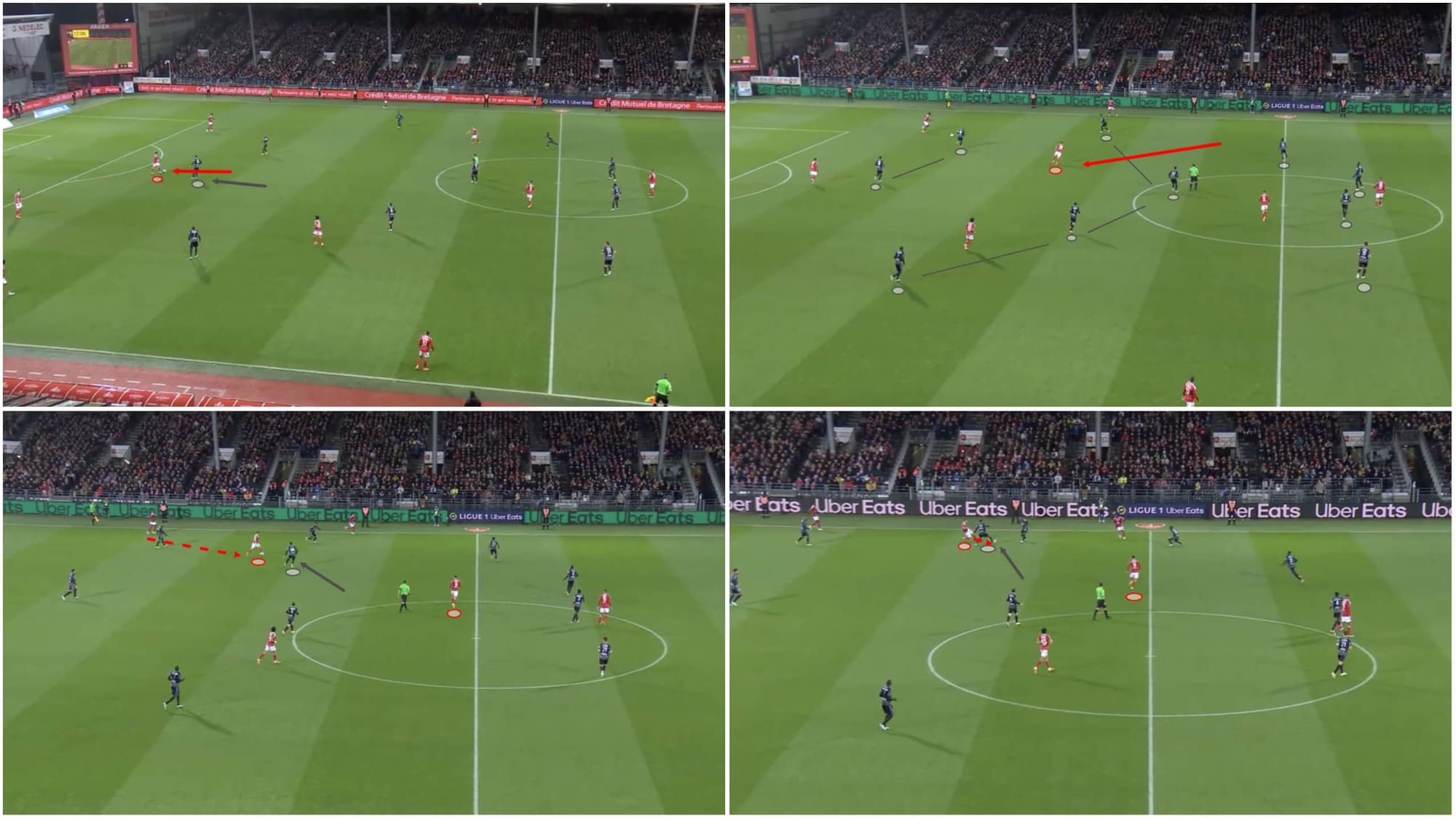
As mentioned above, Cherki would typically man-mark the opposition’s deepest midfielder and this sometimes saw the ‘10’ become a second forward or even the most advanced player in the press when Brest’s holding midfielder dropped between the centre-backs.
This would open up lots of space between Lyon’s forwards and holding midfielders in the centre that could be exploited, as we see in figure 18. However, again, Brest were often too slow on the ball in these key areas to really take advantage of the opportunity afforded to them by Lyon’s open shape. It’s not normal to get so much space in central areas at this level and Brest wasted the opportunities with sluggish football that lacked the sense of urgency required to hurt their opponents.
In figure 18 above, the player who dropped into the central space receives the ball but turns slowly, allowing Tolisso to close in on him and then, instead of getting the ball to the player in the space in front of the backline behind Tolisso, the ex-Bayern man was able to close down the ball carrier, intercept the pass and kill this opportunity very quickly, preventing Brest from progressing to a promising stage of the attack.
So, Lyon weren’t exactly an immovable object themselves without the ball at all times, but Brest failed to punish them as they punished Brest. The difference was made in the two teams’ respective quality on the ball.
This is not to mention the fact that Lyon had a 17-year-old making his first Ligue 1 start at right-back and a 34-year-old centre-back deputising at left-back, while arguably their two biggest creative threats, Del Castillo and Honorat are placed on the wings, yet they didn’t test those full-backs enough in our view and didn’t make exploiting the wide areas as much of a priority as they should have.
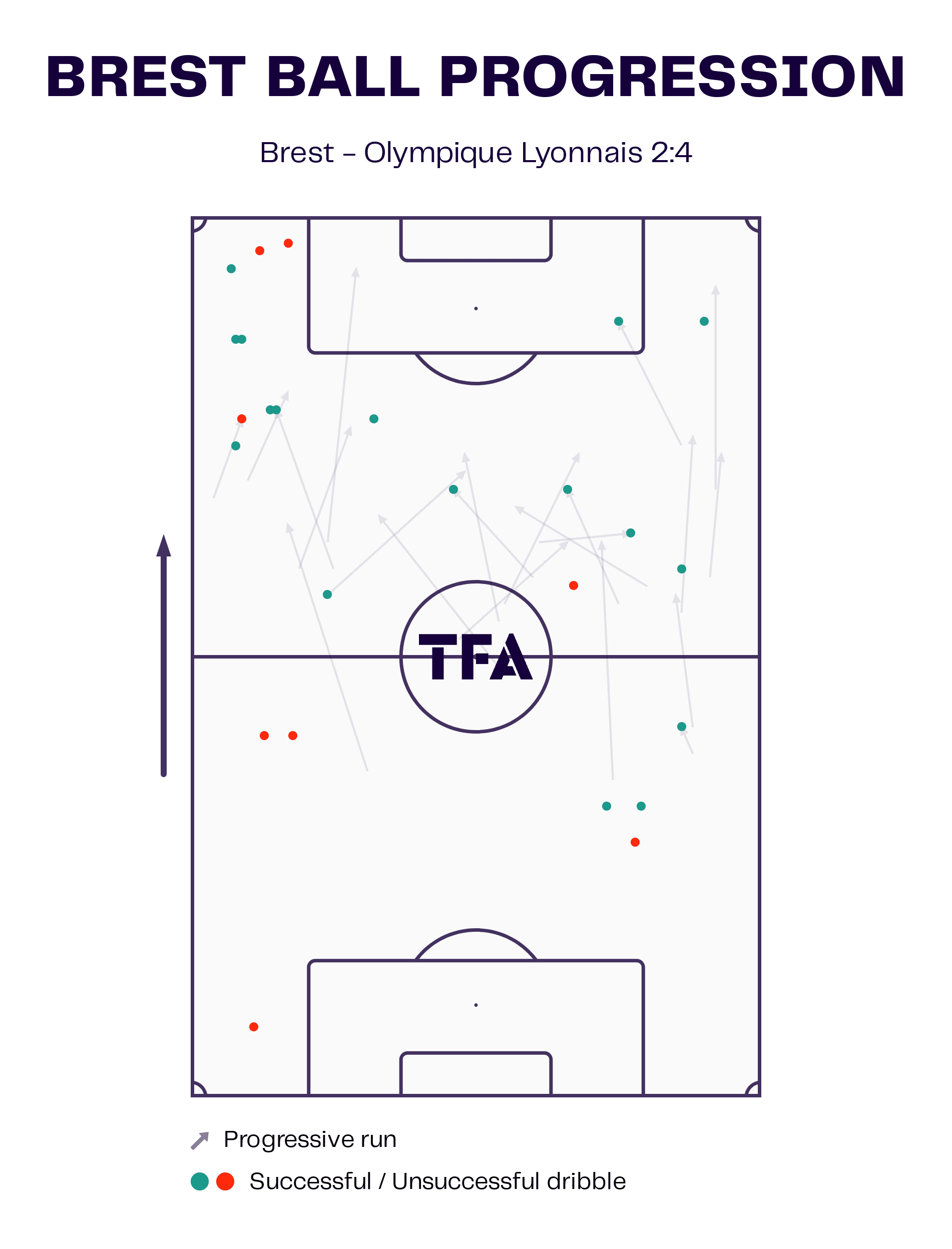
Figure 19 shows Brest’s ball progression in Wednesday’s game and we can see that they were generally successful when they got the ball out wide — this typically occurred later in the game — but there weren’t enough instances of Les Pirates doing this to really benefit from it, especially on Da Silva’s side.
Honorat generated Brest’s highest xGChain in Wednesday’s game, while Del Castillo was third. Only Mounie (second) and Camara (fourth) came anywhere near those two. We believe they could’ve been utilised to an even greater extent to at least test the seemingly vulnerable wide areas. Of course, we have the benefit of hindsight, to be fair to Les Pirates.
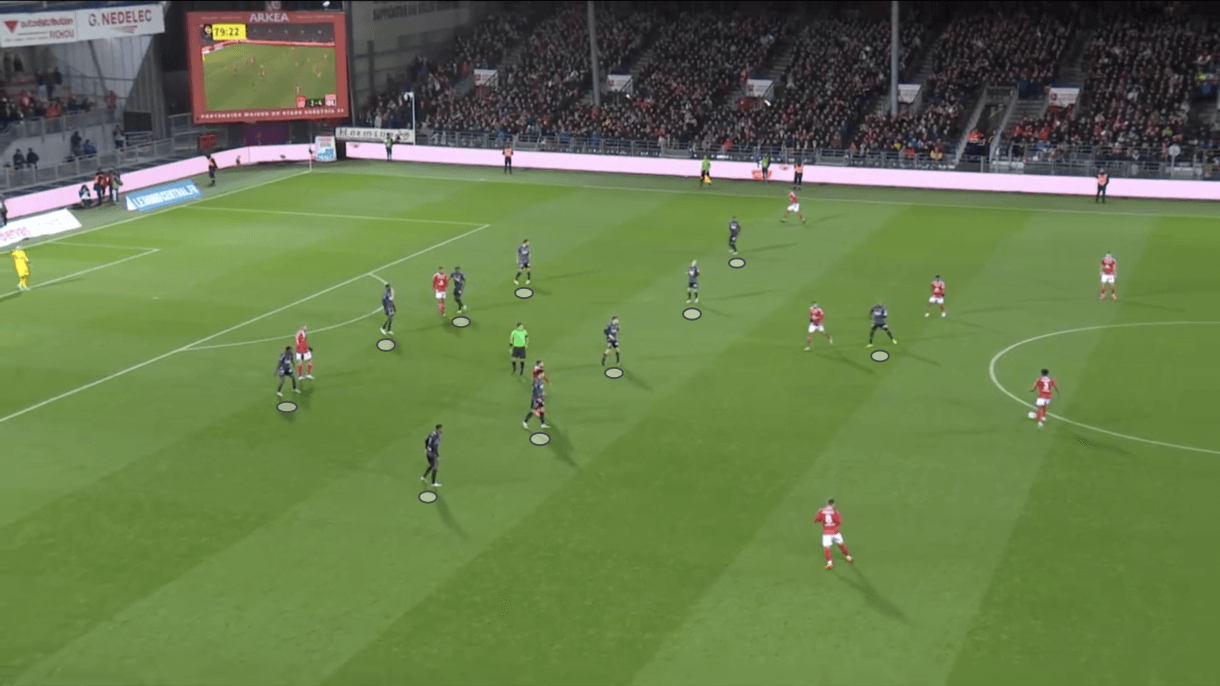
Around the time Faivre came on in the 70th minute, Lyon became far more passive and dropped off a bit deeper, engaging the opposition in lower areas of the pitch, inviting a bit more pressure on. Faivre typically joined the midfield line, forming a 4-5-1 shape as we see in figure 20.
In addition to providing an extra body in midfield, Faivre represented an excellent asset on the counter for Les Gones, as the 24-year-old who joined Lyon from Brest last January is an elite ball carrier over distance, so when Lyon regained possession deep, their first thought was generally to find Faivre and let him do the hard yards carrying the ball forward into a good position, adding significant threat for his side via his progressive run.
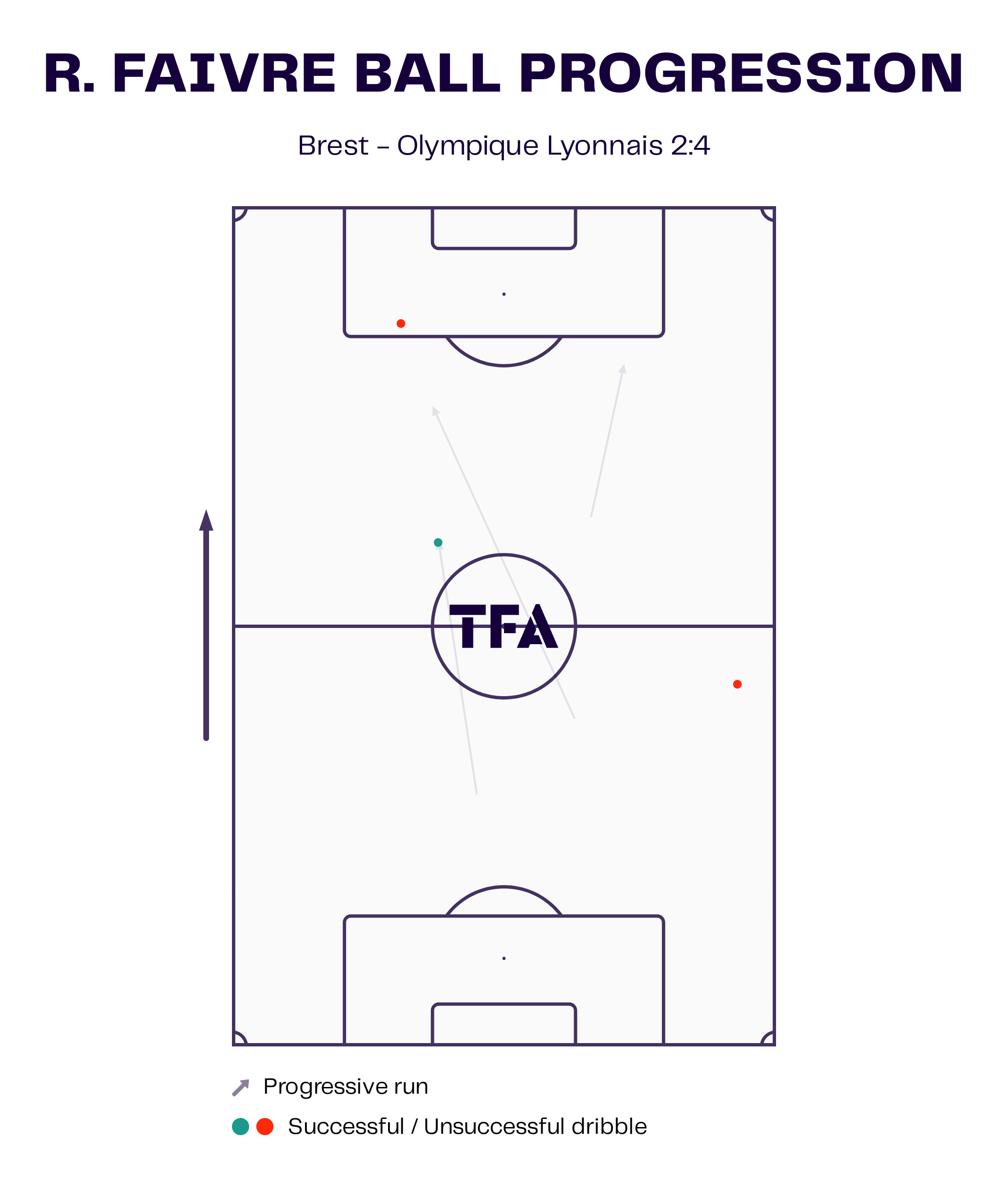
Figure 21 represents Faivre’s ball progression map. Remember, he was only introduced in the 70th minute. However, we can see three impressive progressive runs on this map that helped Lyon to escape pressure and counterattack Brest’s vulnerable defence — this was a significant element of Blanc’s tactics in the latter stages of this game.
So, the 57-year-old did well to utilise Faivre’s strengths, albeit in a cameo appearance.
Conclusion
In conclusion, Lyon’s superiority on the ball, including their players’ off-the-ball movement during possession phases made the big difference between them and Brest on Wednesday, with neither side showering themselves in glory defensively.
It was great to see Cherki, Diomandé, Caqueret and Faivre all play notable roles in one form or another in this game. We highlighted them as four of the five players Blanc had to get more from than his predecessor on his arrival at Groupama Stadium and bravo, Blanc, for achieving that so far. That tactical analysis piece is linked here, for any interested readers: analysis.





Comments